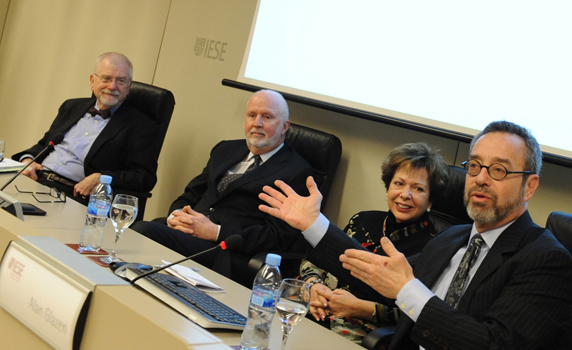
How do you monetize digital? This is the million-dollar question for the billion-dollar media and entertainment industry. And it has no easy answers. Members of IESE US Advisory Board Dr. William T. Baker, IESE Distinguished Professor and President Emeritus of Educational Broadcasting Corporation, Gerry Byrne, Vice Chairman PMC, Carmen DiRienzo, from V-Me Network, and Alan Glazen, formerly of Glazen Creative Studios, joined Prof. Mike Rosenberg on March 7 to broach this and other issues defining the industry’s current crossroads.
In a world where content is king and a Google search can give you all the information you want for free, converting digitization from threat to opportunity will take innovative thinking on the part of the industry’s major players.
Some are already making important moves. Bill Baker cited Comcast’s proposed acquisition of Time Warner Cable for $45.2 billion in stock as one more shift in a landscape in flux. The acquisition will have important implications for content and platform control, and would reach 30% of U.S. households.
If content has become a commodity, there are many reasons to worry beyond financial. "Journalistic content has also become a commodity, but who is making money on it?" asked Dr. Baker, referring to the struggle that The New York Times and other world-class journals face in today’s context. Yet, "if no one is willing to pay for it, we won’t get good journalism, and that is a problem for democracy," he continued.
Alan Glazen pointed out that there are also major concerns about privacy. Though consumers can access content online for free, "the price you pay is your privacy," he said, pointing not just to advertising adjusted to Google searches, but also to issues with tracking and user-generated content.
Transformative Moments
Though an uncertain future raises many reasons for concern, there are also lots of reasons for optimism. "We are really in the embryo stage of a new frontier," said Gerry Byrne. He discussed how PMC has explored new products such as its "Hollywood Life" site created for a millennial female audience, which has attracted 23 million unique visitors. "April 15 of last year, the day of the Boston Marathon bombing, was a transformative moment for us," he explained, pointing out the site’s audience went to Hollywood Life seeking information about the tragedy. "When they find a destination they can trust, they go there first," he said.
Carmen di Rienzo sees many new possibilities ahead, so long as the major players, especially advertisers, are able to transform their traditional business models. She pointed out that the industry has always been driven by three forces: pinpointing what content individuals are interested in, figuring out how to get it to them, and how to make money in the process. In the digitized context, she argued that there is money to be made in how content is curated and distinguished. "The question is how to make it distinguishable for multiple, global audiences," she said.
"Traditionally, we talked about ‘advertising dollars.’ When applied to digital, they are pennies instead," Di Rienzo explained. However, going forward, she argued that advertising has to get creative about how it integrates the products consumers want with content. "There are new opportunities for advertisers to get them the products in multiple ways," she added.
Tailor-made Content
Alan Glazen proposes that individuals turn the tables on the industry and start demanding tailor-made content. "It’s shouldn’t be about ‘their community’" he said, referring to traditional media players, "it’s about ‘my community.’ The more tailored the content is to me, the more I am willing to pay for it." He pointed to Zite, which Flipboard purchased last week for $60 million, as an example of innovative ways for individual consumers to interact with the web, describing the service as somewhat akin to "your personal advocate on the web."
Personalized content is more useful to consumers and that type of service may make them more willing to pay. But other panelists such as Bill Baker questioned whether consumers always know what they want, or how an exclusively filtered interaction with the web will allow them to learn anything new.
Not Mutually Exclusive
Perhaps Glazen’s proposal will be just one answer to the million-dollar question. Yet there will most likely be multiple ways to forge new profitable paths in the digitized landscape. Certainly, the new platforms available to consumers have not displaced traditional distribution systems. "TV is not dead," confirmed Bill Baker pointing out that most people still consume "legacy" TV. The difference is that today they do so while they glance at their tablet or smartphone. The solution to the dilemmas ahead for media and entertainment may be as varied as the multiple ways consumers are finding to satisfy what Carmen Di Renzo calls a "voracious desire for quality content."